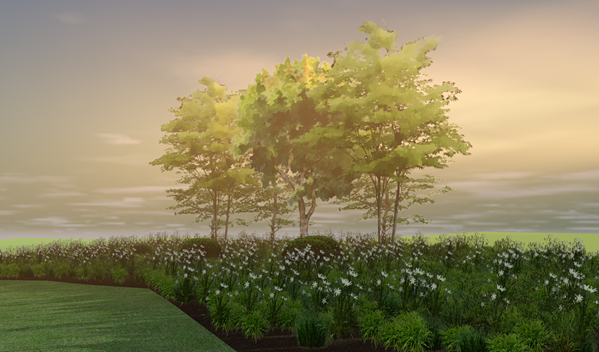Renderworks backgrounds
Renderworks backgrounds provide a variety of different backgrounds for rendering, such as clouds, a color or color gradient, or an imported image or panorama. They can be applied to individual viewports, or to all design layers in a file. They can also be included as part of a Renderworks style. Some Renderworks backgrounds provide only an appropriate background scene for the drawing, but others can also provide lighting for a rendering.
Renderworks backgrounds are resources that are saved with the file and displayed in the Resource Manager; they can be applied to a viewport from the Object Info palette. Renderworks backgrounds can be shared, just like any resource. Several backgrounds are provided in the Vectorworks Libraries, and several of the provided Renderworks styles use backgrounds. You can also create custom Renderworks backgrounds. For more information on creating resources, see Creating resources.

A sunrise Renderworks background with the lit fog effect on gives the scene a golden morning haze
The recommended workflow is to set Renderworks backgrounds by viewport rather than design layer. This allows the flexibility to set a different background for each viewport, and decreases rendering time as you work.
If a Renderworks style that uses a Renderworks background is applied, the background cannot be changed independently.
If you set a Renderworks background for a design layer, all design layers in the drawing use the same background.
If the design layers have a Renderworks background, that is the default background for new viewports; however, if the background is not set by a Renderworks style, you can change it on the Object Info palette for a selected viewport.
Cloud, one-color and two-color backgrounds provide a general background to a drawing, so that it doesn't appear to float in space. They can provide a sense of the horizon when the design has a site or ground, but they do not provide a sense of scale, distance, or site.
An image background is a 2D image placed behind the drawing, similar to the backdrop of a stage set. An image background works well for a viewport with a set view and perspective. However, if the view changes, the image background may no longer work well. In a walk through or flyover of the model, it is possible to see the edges, and even get behind the image, if it is applied to the design layer. If you don't have a panoramic image but want to create a similar effect with a flat image, you can map it to a cylinder or other curved shape and use it to wrap around your model.
Panoramic image backgrounds (including physical sky backgrounds) essentially surround the drawing like a large dome. If you have a panoramic image of the project's site, you can view different parts of the site from different locations in the design.
Panoramic backgrounds can provide environment lighting for the drawing and in some cases realistic environment reflections, in addition to the background. To achieve the needed combination of background and lighting effects, different Renderworks backgrounds can be used to provide the background, the environment lighting, and, in some cases, the environment reflections. Some HDRI images can be used to create panoramic images that reflect light and color, as well.
A physical sky background shows only sky, and not a specific background as a panoramic image does; however, as a type of panoramic image background, it surrounds the drawing and can provide environmental lighting.
A physical sky background can be used with a heliodon (Vectorworks Design Suite product required) to create a realistic sky, correct in appearance for the site's location, date, and time of day.
The lit fog effect is available when a Renderworks background has Lit Fog selected.
